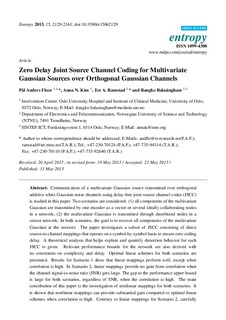| dc.contributor.author | Floor, Pål Anders | |
| dc.contributor.author | Kim, Anna N. | |
| dc.contributor.author | Ramstad, Tor Audun | |
| dc.contributor.author | Balasingham, Ilangko | |
| dc.date.accessioned | 2015-09-17T09:47:08Z | |
| dc.date.accessioned | 2016-04-28T11:37:33Z | |
| dc.date.available | 2015-09-17T09:47:08Z | |
| dc.date.available | 2016-04-28T11:37:33Z | |
| dc.date.issued | 2013-05-31 | |
| dc.identifier.citation | Entropy 2013, 15(6):2129-2161 | nb_NO |
| dc.identifier.issn | 1099-4300 | |
| dc.identifier.uri | http://hdl.handle.net/11250/2387801 | |
| dc.description.abstract | Communication of a multivariate Gaussian source transmitted over orthogonal additive white Gaussian noise channels using delay-free joint source channel codes (JSCC) is studied in this paper. Two scenarios are considered: (1) all components of the multivariate Gaussian are transmitted by one encoder as a vector or several ideally collaborating nodes in a network; (2) the multivariate Gaussian is transmitted through distributed nodes in a sensor network. In both scenarios, the goal is to recover all components of the multivariate Gaussian at the receiver. The paper investigates a subset of JSCC consisting of direct source-to-channel mappings that operate on a symbol-by-symbol basis to ensure zero coding delay. A theoretical analysis that helps explain and quantify distortion behavior for such JSCC is given. Relevant performance bounds for the network are also derived with no constraints on complexity and delay. Optimal linear schemes for both scenarios are presented. Results for Scenario 1 show that linear mappings perform well, except when correlation is high. In Scenario 2, linear mappings provide no gain from correlation when the channel signal-to-noise ratio (SNR) gets large. The gap to the performance upper bound is large for both scenarios, regardless of SNR, when the correlation is high. The main contribution of this paper is the investigation of nonlinear mappings for both scenarios. It is shown that nonlinear mappings can provide substantial gain compared to optimal linear schemes when correlation is high. Contrary to linear mappings for Scenario 2, carefully chosen nonlinear mappings provide a gain for all SNR, as long as the correlation is close to one. Both linear and nonlinear mappings are robust against variations in SNR. | nb_NO |
| dc.language.iso | eng | nb_NO |
| dc.publisher | MDPI | nb_NO |
| dc.rights | Navngivelse 3.0 Norge | * |
| dc.rights.uri | http://creativecommons.org/licenses/by/3.0/no/ | * |
| dc.title | Zero Delay Joint Source Channel Coding for Multivariate Gaussian Sources over Orthogonal Gaussian Channels | nb_NO |
| dc.type | Journal article | nb_NO |
| dc.type | Peer reviewed | nb_NO |
| dc.date.updated | 2015-09-17T09:47:08Z | |
| dc.source.pagenumber | 2129-2161 | nb_NO |
| dc.source.volume | 15 | nb_NO |
| dc.source.journal | Entropy | nb_NO |
| dc.source.issue | 6 | nb_NO |
| dc.identifier.doi | 10.3390/e15062129 | |
| dc.identifier.cristin | 1107029 | |
| dc.description.localcode | This is an open access article distributed under the Creative Commons Attribution License (CC BY) which permits unrestricted use, distribution, and reproduction in any medium, provided the original work is properly cited. | nb_NO |

